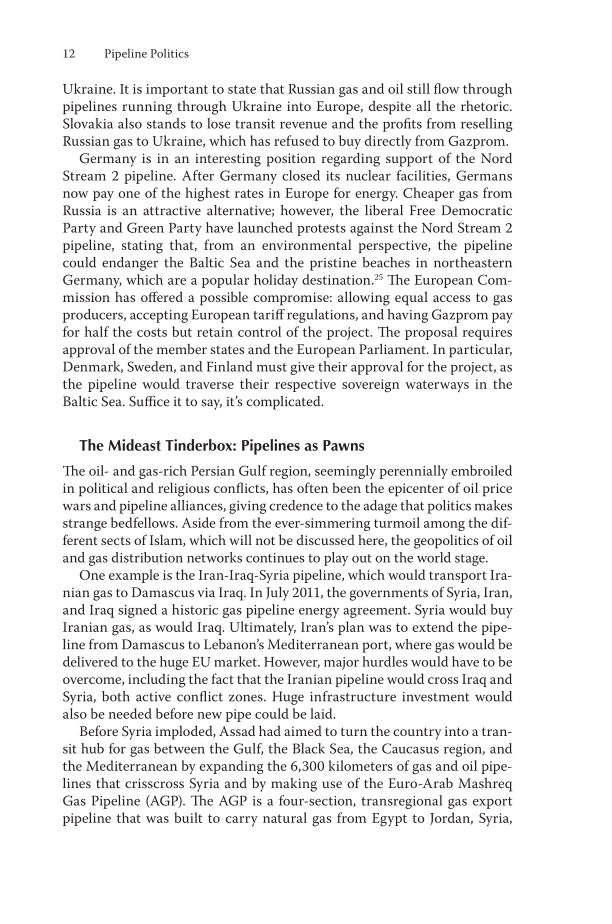12 Pipeline Politics Ukraine. It is important to state that Russian gas and oil still flow through pipelines running through Ukraine into Europe, despite all the rhetoric. Slovakia also stands to lose transit revenue and the profits from reselling Russian gas to Ukraine, which has refused to buy directly from Gazprom. Germany is in an interesting position regarding support of the Nord Stream 2 pipeline. After Germany closed its nuclear facilities, Germans now pay one of the highest rates in Europe for energy. Cheaper gas from Russia is an attractive alternative however, the liberal Free Democratic Party and Green Party have launched protests against the Nord Stream 2 pipeline, stating that, from an environmental perspective, the pipeline could endanger the Baltic Sea and the pristine beaches in northeastern Germany, which are a popular holiday destination.25 The European Com- mission has offered a possible compromise: allowing equal access to gas producers, accepting European tariff regulations, and having Gazprom pay for half the costs but retain control of the project. The proposal requires approval of the member states and the European Parliament. In particular, Denmark, Sweden, and Finland must give their approval for the project, as the pipeline would traverse their respective sovereign waterways in the Baltic Sea. Suffice it to say, it’s complicated. The Mideast Tinderbox: Pipelines as Pawns The oil- and gas-rich Persian Gulf region, seemingly perennially embroiled in political and religious conflicts, has often been the epicenter of oil price wars and pipeline alliances, giving credence to the adage that politics makes strange bedfellows. Aside from the ever-simmering turmoil among the dif- ferent sects of Islam, which will not be discussed here, the geopolitics of oil and gas distribution networks continues to play out on the world stage. One example is the Iran-Iraq-Syria pipeline, which would transport Ira- nian gas to Damascus via Iraq. In July 2011, the governments of Syria, Iran, and Iraq signed a historic gas pipeline energy agreement. Syria would buy Iranian gas, as would Iraq. Ultimately, Iran’s plan was to extend the pipe- line from Damascus to Lebanon’s Mediterranean port, where gas would be delivered to the huge EU market. However, major hurdles would have to be overcome, including the fact that the Iranian pipeline would cross Iraq and Syria, both active conflict zones. Huge infrastructure investment would also be needed before new pipe could be laid. Before Syria imploded, Assad had aimed to turn the country into a tran- sit hub for gas between the Gulf, the Black Sea, the Caucasus region, and the Mediterranean by expanding the 6,300 kilometers of gas and oil pipe- lines that crisscross Syria and by making use of the Euro-Arab Mashreq Gas Pipeline (AGP). The AGP is a four-section, transregional gas export pipeline that was built to carry natural gas from Egypt to Jordan, Syria,
Document Details My Account Print multiple pages
Print
You have printed 0 times in the last 24 hours.
Your print count will reset on at .
You may print 0 more time(s) before then.
You may print a maximum of 0 pages at a time.




















































































































































































































































